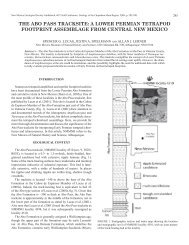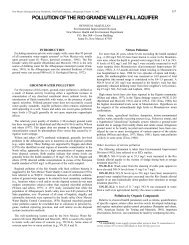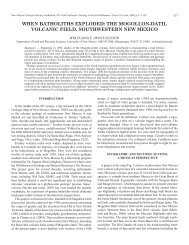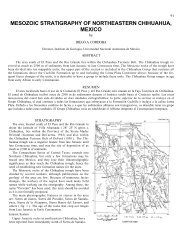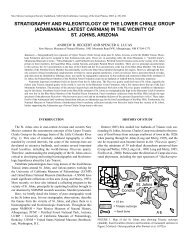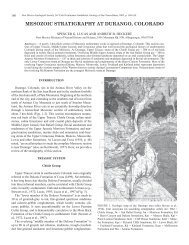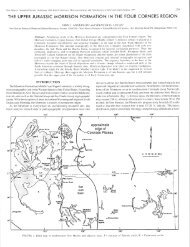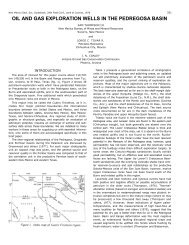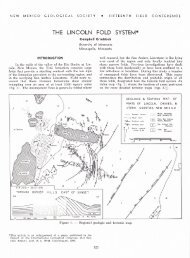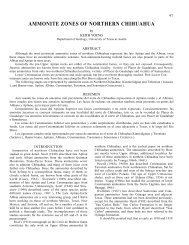Tectonic Style and Deformational Environment in the Eagle ...
Tectonic Style and Deformational Environment in the Eagle ...
Tectonic Style and Deformational Environment in the Eagle ...
Create successful ePaper yourself
Turn your PDF publications into a flip-book with our unique Google optimized e-Paper software.
128 REASER <strong>and</strong> UNDERWOOD<br />
Parker (p. 60), "Flexural mechanisms depend on <strong>the</strong> presence of<br />
mechanical anisotropy <strong>and</strong> operate most commonly <strong>in</strong> deformational<br />
environments characterized by low to moderate pressures<br />
<strong>and</strong> low temperature."<br />
They po<strong>in</strong>ted out (Fig. 3, p. 50-51) that under near-surface conditions<br />
a sequence of limestone or of limestone <strong>and</strong> shale could fold<br />
by flexural slip.<br />
Cries <strong>and</strong> Haenggi (Haenggi, 1966; Cries <strong>and</strong> Haenggi, 1969;<br />
Cries, 1970; Haenggi <strong>and</strong> Cries, 1970; Cries <strong>and</strong> Haenggi, 1970)<br />
after study<strong>in</strong>g a large part of nor<strong>the</strong>astern Chihuahua, concluded<br />
that Cretaceous rocks <strong>in</strong> <strong>the</strong> Chihuahua Trough were <strong>in</strong>tensely<br />
deformed along a decollement zone dur<strong>in</strong>g <strong>the</strong> Laramide orogeny.<br />
They elaborated on <strong>the</strong> structural development of <strong>the</strong>se<br />
rocks <strong>in</strong> nor<strong>the</strong>astern Chihuahua <strong>and</strong> remarked (cries <strong>and</strong><br />
Haenggi, 1969) that Laramide overfolds <strong>and</strong> eastward-displaced<br />
thrust blocks of Cretaceous rocks <strong>in</strong> <strong>the</strong> eastern Chihuahua <strong>Tectonic</strong><br />
Belt resulted from decollement on Jurassic(?) evaporites.<br />
The lack of significant thicken<strong>in</strong>g <strong>and</strong> th<strong>in</strong>n<strong>in</strong>g of folded beds suggests<br />
that <strong>the</strong>y were deformed by flexural slip fold<strong>in</strong>g. The <strong>in</strong>tensity<br />
of fractures, moreover, suggests that deformation occurred <strong>in</strong><br />
a relatively low-temperature low-pressure environment where<br />
brittle deformation, ra<strong>the</strong>r than plastic deformation, was dom<strong>in</strong>ant.<br />
Fold geometry <strong>and</strong> o<strong>the</strong>r characteristics coupled with <strong>the</strong> <strong>in</strong>tensity<br />
<strong>and</strong> shallow depth of fold<strong>in</strong>g <strong>in</strong> <strong>the</strong> sou<strong>the</strong>rn Quitmans suggest<br />
deformation of a stratal "carpet" as might be expected <strong>in</strong> <strong>the</strong><br />
plis de couvertu re of a decollement or <strong>in</strong> <strong>the</strong> upper plate of a large<br />
bedd<strong>in</strong>g thrust fault.<br />
SUMMARY<br />
The north-northwest to northwest trend of folds <strong>and</strong> thrust faults<br />
formed dur<strong>in</strong>g <strong>the</strong> Laramide orogeny <strong>in</strong>dicate that <strong>the</strong> directions<br />
of maximum compressive stress were oriented generally eastnor<strong>the</strong>ast<br />
<strong>and</strong> nor<strong>the</strong>ast to south-southwest <strong>and</strong> southwest. Welldeveloped<br />
conjugate shear patterns on <strong>the</strong> flanks of some folds<br />
support this conclusion. The <strong>in</strong>termediate stress was horizontal,<br />
parallel to <strong>the</strong> trend of major folds, <strong>and</strong> normal to <strong>the</strong> direction of<br />
maximum stress; locally, dur<strong>in</strong>g strike-slip fault<strong>in</strong>g, this was also<br />
<strong>the</strong> direction of m<strong>in</strong>imum stress. The m<strong>in</strong>imum stress dur<strong>in</strong>g fold<strong>in</strong>g<br />
<strong>and</strong> development of thrust faults was vertical.<br />
Large northwest- to north-northwest-trend<strong>in</strong>g normal faults <strong>in</strong><br />
<strong>the</strong> region, such as <strong>the</strong> Caballo <strong>and</strong> Schroeder faults along <strong>the</strong><br />
west side of <strong>the</strong> Quitman Mounta<strong>in</strong>s (Jones <strong>and</strong> Reaser, 1970), <strong>the</strong><br />
Indio fault along <strong>the</strong> axis of <strong>the</strong> Indio Mounta<strong>in</strong>s, <strong>and</strong> <strong>the</strong> unnamed<br />
fault along <strong>the</strong> west side of <strong>the</strong> Indio Mounta<strong>in</strong>s (Underwood,<br />
1963) <strong>in</strong>dicate a reorientation of stresses <strong>in</strong> mid- to late Tertiary<br />
time. Dur<strong>in</strong>g fault<strong>in</strong>g <strong>the</strong> maximum stress axis was vertical, <strong>the</strong><br />
<strong>in</strong>termediate stress axis was horizontal <strong>and</strong> <strong>in</strong> <strong>the</strong> plane of <strong>the</strong><br />
fault, <strong>the</strong> m<strong>in</strong>imum stress axis was oriented nor<strong>the</strong>ast-southwest.<br />
Asymmetrical folds occur throughout <strong>the</strong> <strong>Eagle</strong>-sou<strong>the</strong>rn Quitman<br />
Mounta<strong>in</strong>s; such folds are more common <strong>in</strong> <strong>the</strong> sou<strong>the</strong>rn<br />
Quitmans. Most, but not all, of <strong>the</strong> folds are asymmetrical to <strong>the</strong><br />
east or nor<strong>the</strong>ast. DeSitter (1956, p. 239-246) has suggested that<br />
asymmetry of folds arises ma<strong>in</strong>ly 1) from differences <strong>in</strong> thickness of<br />
<strong>the</strong> folded strata along a bas<strong>in</strong> marg<strong>in</strong>, <strong>and</strong> 2) from an orig<strong>in</strong>al difference<br />
<strong>in</strong> elevation between <strong>the</strong> limbs of a fold.<br />
The th<strong>in</strong>n<strong>in</strong>g of <strong>the</strong> strata of <strong>the</strong> Chihuahua Trough toward <strong>the</strong><br />
Diablo Platform is well documented. Because <strong>the</strong> radius of curvature<br />
of a fold is directly proportional to <strong>the</strong> thickness of <strong>the</strong><br />
strata <strong>in</strong>volved <strong>in</strong> <strong>the</strong> fold<strong>in</strong>g, <strong>the</strong> limb of <strong>the</strong> fold nearest <strong>the</strong> platform<br />
will have a shorter radius <strong>and</strong> thus a steeper dip.<br />
Asymmetric folds also form where an orig<strong>in</strong>al difference <strong>in</strong> eleva-<br />
tion exists between flanks of a fold. Where an area border<strong>in</strong>g a<br />
trough is uplifted while fold<strong>in</strong>g commences, <strong>the</strong> steep limb of <strong>the</strong><br />
result<strong>in</strong>g asymmetrical fold will be toward <strong>the</strong> trough. If, however,<br />
<strong>the</strong> strata of <strong>the</strong> trough were uplifted relative to <strong>the</strong> marg<strong>in</strong>al area,<br />
<strong>the</strong> asymmetry of <strong>the</strong> folds would be toward <strong>the</strong> marg<strong>in</strong>al area.<br />
Undoubtedly, such factors as <strong>the</strong>se, plus irregularities of <strong>the</strong> basement,<br />
pre-exist<strong>in</strong>g folds <strong>in</strong> older strata, competence <strong>and</strong> <strong>in</strong>competence<br />
of strata, <strong>and</strong> o<strong>the</strong>rs, <strong>in</strong>terrelate <strong>in</strong> a complex way to<br />
control <strong>the</strong> direction <strong>and</strong> degree of asymmetry.<br />
Do <strong>the</strong> thrust faults penetrate to <strong>the</strong> Precambrian? This question<br />
cannot be answered certa<strong>in</strong>ly with present data, but no thrust fault<br />
<strong>in</strong> <strong>the</strong> <strong>Eagle</strong>-sou<strong>the</strong>rn Quitman Mounta<strong>in</strong>s region br<strong>in</strong>gs Precambrian<br />
rocks to <strong>the</strong> surface. Probably <strong>the</strong> major thrust faults, <strong>and</strong><br />
almost certa<strong>in</strong>ly <strong>the</strong> m<strong>in</strong>or ones, flatten at depth <strong>and</strong> become bedd<strong>in</strong>g-plane<br />
faults with<strong>in</strong> <strong>the</strong> lower part of <strong>the</strong> Cretaceous section<br />
or with<strong>in</strong> <strong>the</strong> Jurassic section.<br />
In <strong>the</strong> sou<strong>the</strong>rn Quitmans, <strong>the</strong> crustal shorten<strong>in</strong>g of <strong>the</strong> Laramide<br />
orogeny was accommodated by <strong>in</strong>tense fold<strong>in</strong>g, whereas <strong>in</strong> <strong>the</strong><br />
<strong>Eagle</strong> Mounta<strong>in</strong>s, Indio Mounta<strong>in</strong>s, Devil Ridge complex shorten<strong>in</strong>g<br />
was achieved primarily by thrust fault<strong>in</strong>g <strong>and</strong> more open fold<strong>in</strong>g.<br />
This may have resulted from <strong>the</strong> rocks <strong>in</strong> <strong>the</strong> sou<strong>the</strong>rn Quitman<br />
Mounta<strong>in</strong>s hav<strong>in</strong>g been deformed along a zone of decollement.<br />
Because <strong>the</strong> Jurassic(?) evaporite sequence of <strong>the</strong> Chihuahua<br />
Trough presumably does not underlie <strong>the</strong> <strong>Eagle</strong> Mounta<strong>in</strong>s-Indio<br />
Mounta<strong>in</strong>s-Devil Ridge area (DeFord <strong>and</strong> Haenggi, 1970, Fig. 4, p.<br />
181), deformation <strong>the</strong>re was characterized by <strong>in</strong>tense fractur<strong>in</strong>g<br />
ra<strong>the</strong>r than by fold<strong>in</strong>g.<br />
PLATE TECTONIC IMPLICATIONS<br />
Muehlberger (this guidebook) gives an excellent summary of tectonic<br />
events <strong>in</strong> <strong>the</strong> region from Precambrian time to <strong>the</strong> present.<br />
The tectonic history of <strong>the</strong> <strong>Eagle</strong>-Quitman mounta<strong>in</strong> area is complex<br />
<strong>and</strong> a complete tectonic analysis of <strong>the</strong> area awaits fur<strong>the</strong>r<br />
study; however, regional geology allows a few speculations concern<strong>in</strong>g<br />
Mesozoic <strong>and</strong> early Cenozoic plate activity to be made.<br />
This part of our paper is <strong>in</strong>tended to be a "pot boiler" <strong>and</strong> should<br />
generate heated discussion on <strong>the</strong> outcrop.<br />
The area of <strong>in</strong>vestigation lies along a proposed southward extension<br />
of <strong>the</strong> Overthrust Belt of western North America (Drewes,<br />
1978). Therefore, <strong>the</strong> general plate tectonic orig<strong>in</strong> of <strong>the</strong> region,<br />
with local modifications, can probably be fitted <strong>in</strong>to <strong>the</strong> overall<br />
pattern of <strong>the</strong> Mesozoic Cordilleran orogenic belt. Drewes (1978)<br />
suggested that <strong>the</strong> orogenic belt resulted from convergence of<br />
two active plates dur<strong>in</strong>g Jurassic <strong>and</strong> Cretaceous time. These tectonic<br />
elements were <strong>the</strong> nor<strong>the</strong>astward-mov<strong>in</strong>g, oceanic Farallon<br />
plate on <strong>the</strong> west <strong>and</strong> <strong>the</strong> westward-mov<strong>in</strong>g, cratonic Americas<br />
plate on <strong>the</strong> east. Accord<strong>in</strong>g to Drewes, "<strong>the</strong> oceanic plate was<br />
subducted beneath <strong>the</strong> western marg<strong>in</strong> of <strong>the</strong> cont<strong>in</strong>ental<br />
plate . . . " The cont<strong>in</strong>ental plate consisted of a cratonic core with<br />
a flank<strong>in</strong>g wedge of miogeosyncl<strong>in</strong>al deposits. In <strong>the</strong> study area,<br />
<strong>the</strong> flank<strong>in</strong>g sedimentary prism would <strong>in</strong>clude deposits <strong>in</strong> <strong>the</strong> Chihuahua<br />
Trough. It should be noted that Muehlberger (this Guidebook)<br />
relates development of <strong>the</strong> Chihuahua Trough to open<strong>in</strong>g<br />
of <strong>the</strong> Gulf of Mexico <strong>in</strong> mid-Mesozoic. The western cont<strong>in</strong>ental<br />
plate marg<strong>in</strong> is not clearly def<strong>in</strong>ed but was probably near <strong>the</strong><br />
eastern edge of <strong>the</strong> north-northwest-trend<strong>in</strong>g ancestral Baja California<br />
Trough of de Cserna (1970, fig. 5, p. 106) dur<strong>in</strong>g Late Jurassic<br />
time. Dick<strong>in</strong>son <strong>and</strong> Yarbrough (1979, fig. 22-A) show a subduction<br />
(trench) complex dur<strong>in</strong>g middle Cretaceous time along Baja<br />
California <strong>and</strong> <strong>the</strong> Gulf of California (fig. 9). Although remote<br />
relative to <strong>the</strong> subduction zone, strata deposited <strong>in</strong> <strong>the</strong> Chihuahua<br />
Trough were affected by <strong>the</strong> compressional stresses generated by




